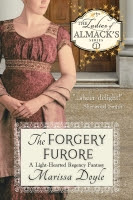 Our century was definitely the golden age of the men’s club, a place where gentlemen and the nobility went to hang out with each other, read the papers, gamble, and conduct what we today call “networking”…and one of the more interesting of these clubs was also one of the shortest-lived, being on operation for only twelve years. But for those twelve years, Watier’s was one of the most fashionable of masculine London hangouts, and one of the few clubs to lack a political slant. The nickname Watier’s was most known by was “the Dandy Club”, which should tell you everything about the interests of its members.
Our century was definitely the golden age of the men’s club, a place where gentlemen and the nobility went to hang out with each other, read the papers, gamble, and conduct what we today call “networking”…and one of the more interesting of these clubs was also one of the shortest-lived, being on operation for only twelve years. But for those twelve years, Watier’s was one of the most fashionable of masculine London hangouts, and one of the few clubs to lack a political slant. The nickname Watier’s was most known by was “the Dandy Club”, which should tell you everything about the interests of its members.Its origins are lofty ones. According to Captain Rees Gronow, a fashionable man-about-town of the time whose diary makes fascinating reading, Watier’s was the brain-child of the Prince Regent himself. At a dinner one evening in 1807, Prinny asked his friends (members of White’s and Brooks’s, two of the premier clubs of London) about the dining at their clubs, and was told that the food was universally awful: "the eternal joints, or beef-steaks, the boiled fowl with oyster sauce, and an apple tart--this is what we have, sir, at our clubs, and very monotonous far it is". Then and there, Prinny (who as you might recall, was quite the gourmet) proposed that they start their own club, dedicated to the French art of “gastronomy.” His best friend, Beau Brummell, was appointed President in perpetuity, and Prinny’s own personal chef, Jean Baptiste Watier, was summoned from the kitchen to weigh in on the matter. Though he declined to be the new club’s cook (or Prinny didn’t want to lose his chef!), the club was named in his honor and another royal chef, Monsieur Labourie, became chef; one of Prinny’s pages, Madison, was named manager.
 And the result? Though Watier’s was initially billed as a musical society and singing club, it soon became known as the finest dining establishment in London, with food unmatched even by the best Parisian cooks…but it also became known as a gambling house where the stakes were incredibly high (evidently the singing wasn’t enough!) Beau Brummell’s fine athletic figure suffered as a result of his presidency, and so did his pocketbook: too much fine dining and playing at high-stakes Macao saw the beginning of his ruin, which would be complete in 1816 when he and the Prince had a falling-out. After the Beau’s flight to France to avoid his creditors, Watier’s fell apart, and in 1819 it closed.
And the result? Though Watier’s was initially billed as a musical society and singing club, it soon became known as the finest dining establishment in London, with food unmatched even by the best Parisian cooks…but it also became known as a gambling house where the stakes were incredibly high (evidently the singing wasn’t enough!) Beau Brummell’s fine athletic figure suffered as a result of his presidency, and so did his pocketbook: too much fine dining and playing at high-stakes Macao saw the beginning of his ruin, which would be complete in 1816 when he and the Prince had a falling-out. After the Beau’s flight to France to avoid his creditors, Watier’s fell apart, and in 1819 it closed.But its legacy lived on, and ten years later Crockford’s Club was established, also dedicated to fine dining and featuring superstar chefs Louis Eustache Ude and Charles Francatelli, who went on to become Queen Victoria’s personal chef.





3 comments:
Wow, so there were celebrity chefs before Wolfgang Puck and Bobby Flay! I always wondered what men did at their clubs when I read about them in Georgette Heyer books. And they could just go whenever without making a reservation - how did the chefs know how much food to make?
Hi pie,
Yes, celebrity chefs definitely pre-date The Food Channel. There's anexcellent book by Ian Kelly called "Cooking for Kings: the Life of Antonin Careme, the First Celebrity Chef" that you might find interesting if you want to learn more.
And yes, club members just showed up at their clubs when they wanted to, and dined (or didn't) as they wanted to. If someone wanted to plan something a little special--say, a party, then yes, he might set it up beforehand. A gentleman's club was almost a second home, especially if he were a bachelor living in lodgings--and for married men, it was a place to go to avoid female companionship and read the paper in peace if one wasn't in the mood to be gallant. :)
And as for chefs being prepared...I imagine that experience and the time of year (Parliament in session or not) would help them guesstimate how much food prep they'd have to do.
Post a Comment